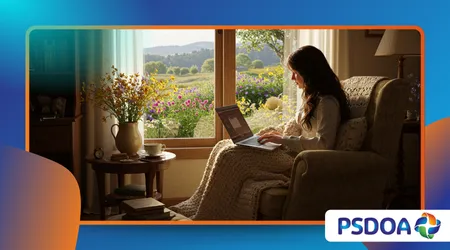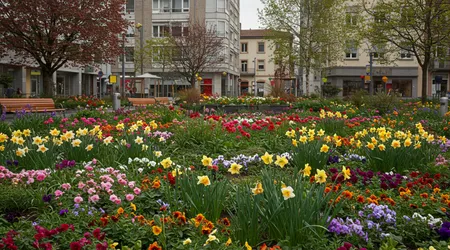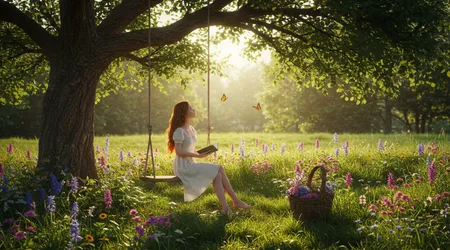Inside the World of Cottagecore: Escapism in the Digital Age

The world of Cottagecore blooms as a digital haven, where rustic charm meets modern yearning for simplicity.
Anúncios
In 2025, this aesthetic subculture thrives on platforms like TikTok and Instagram, offering an escape from the relentless pace of urban life and digital overload.
It’s not just about floral dresses or cozy cabins; it’s a deliberate rebellion against the chaos of modernity, a curated fantasy of pastoral serenity.
Rooted in nostalgia, the world of Cottagecore resonates with Millennials and Gen Z, who seek solace in a romanticized rural idyll.
According to a 2023 WGSN report, #Cottagecore reached 0.5% penetration in online conversations, reflecting its growing cultural weight.
Anúncios
This article dives into why this subculture captivates, how it shapes digital identities, and what it reveals about our collective desire for escape.
Cottagecore isn’t a fleeting trend; it’s a lifestyle that blends aesthetics with ideology. Picture a young woman in a linen apron, kneading sourdough in a sunlit kitchen, or a queer couple sharing a picnic in a meadow, free from societal constraints.
These vignettes, often shared in short TikTok loops, embody the world of Cottagecore a space where self-sufficiency and nature intertwine.
Yet, this subculture isn’t without critique. Is it a genuine push for simpler living, or a polished illusion that ignores rural realities?
Let’s explore its roots, expressions, and implications in today’s hyper-connected age.
The Roots of Cottagecore: A Historical Tapestry
Cottagecore’s allure stems from a longing for a pre-industrial past. The world of Cottagecore draws from pastoral traditions, like the Hellenistic Greeks’ Arcadia, where shepherds lived in idyllic leisure.
Fast-forward to the 18th century, Marie Antoinette’s Hameau de la Reine at Versailles symbolized an elite’s escapist fantasy, a rustic retreat from courtly pressures.
These historical threads weave into modern Cottagecore, which emerged on Tumblr in 2018, named for its focus on cozy, rural aesthetics.
Romanticism also fuels this subculture. Rousseau’s reverence for nature and William Morris’ neo-Medieval craft movement echo in Cottagecore’s emphasis on handmade goods.
In 2025, this translates to Gen Z knitting scarves or baking bread, acts of creation that reject mass production. These practices aren’t just nostalgic; they’re a quiet protest against capitalism’s grind, offering a sense of agency in a world of algorithms.
++ Get Approved for Your Residential Mortgage Loan the Smart Way 🏡
Yet, this romanticized past isn’t universal. Critics note Cottagecore’s Eurocentric lens, often sidelining non-Western rural traditions.
The aesthetic’s focus on white, pastoral imagery can feel exclusive, ignoring the diverse realities of rural life.
Still, its appeal lies in its adaptability anyone with a smartphone can join the world of Cottagecore, crafting their own narrative of escape.

Digital Platforms: The Fertile Soil of Cottagecore
Social media is the lifeblood of the world of Cottagecore. TikTok’s algorithm, with its knack for curating niche content, has propelled Cottagecore to billions of views #Cottagecore amassed 12 billion by mid-2025.
Short videos of foraging or cottage gardening resonate because they’re accessible, offering bite-sized escapes.
Instagram’s curated grids, meanwhile, showcase polished Cottagecore aesthetics, from wildflower bouquets to vintage teacups.
These platforms don’t just spread Cottagecore; they shape it. Hashtags like #CottagecoreLesbian highlight inclusive subcommunities, where queer identities find a safe space in pastoral fantasies.
Also read: The Hidden World of Urban Exploration (Urbex) Subculture
Yet, algorithms can commodify these spaces, pushing branded “nap dresses” or $500 art prints, as noted by influencer Katie Calautti in 2022. This tension authenticity versus commercialization defines the digital world of Cottagecore.
The paradox is stark: a subculture rooted in anti-modernity thrives on modern technology. Creators film rustic scenes with high-tech cameras, sharing them globally.
This blend of old and new mirrors our broader digital existence, where we seek grounding in a world of screens. Cottagecore’s digital roots make it both universal and deeply personal.
Escapism or Activism? The Philosophy of Cottagecore
At its core, the world of Cottagecore is about escapism a refuge from urban stress and digital noise. Psychologist Krystine Batcho told CNN in 2020 that nostalgia, like Cottagecore, counters stress by evoking simpler times.
In 2025, with global uncertainties like climate change and economic instability, this escape feels vital. Followers don’t just dream of cottages; they enact rituals like gardening to reclaim control.
But is Cottagecore merely a daydream? Some argue it’s a budding anti-capitalist movement. By valuing handmade crafts and sustainable practices, it challenges consumer culture.
Read more: The DIY Zine Culture That Refuses to Die
For example, a TikTok user might share a tutorial on upcycling thrifted clothes, aligning with slow fashion. These acts, small as they seem, foster self-sufficiency and environmental awareness, resonating with Gen Z’s eco-conscious ethos.
Critics, however, see escapism as avoidance. Rural life isn’t always idyllic poverty and isolation are real.
Cottagecore’s glossy veneer can gloss over these truths, as Vox’s Rebecca Jennings noted in 2021, highlighting its paradox: a modest life is unattainable for some, inescapable for others.
Yet, its aspirational nature inspires tangible actions, like urban gardening, bridging fantasy and reality.
The Aesthetic Language of Cottagecore
Cottagecore’s visual grammar is unmistakable: soft pastels, gingham, and wildflowers. The world of Cottagecore paints a picture of pastoral femininity, with prairie dresses and wicker baskets.
This aesthetic isn’t just pretty; it’s a deliberate choice to evoke calm. Soundscapes, like the 2005 Pride & Prejudice score, amplify this mood, looping in TikTok videos to soothe viewers.
This aesthetic extends beyond fashion. Home decor leans into vintage teapots and embroidered linens, while activities like baking or foraging become performative art.
Consider Sarah, a 24-year-old from London, who posts videos of her rooftop herb garden, blending urban life with Cottagecore ideals. Her followers see not just beauty but a lifestyle they can emulate, even in small ways.
Yet, this aesthetic can be a double-edged sword. Fast fashion brands exploit it, churning out “Cottagecore-inspired” collections that clash with the subculture’s sustainable ethos.
The challenge is maintaining authenticity in a world where aesthetics are easily co-opted. Still, creators like Sarah push back, prioritizing thrifted finds over mass-produced goods.
Community and Identity in the Digital Cottage
The world of Cottagecore fosters community, uniting strangers through shared aesthetics. On TikTok, users connect over #BookTok, where Cottagecore overlaps with literary romanticism, boosting young adult fiction sales by 30.7% from 2020 to 2021, per NPD Bookscan.
These digital tribes offer belonging, especially for marginalized groups like queer women, who find empowerment in Cottagecore’s non-heteronormative spaces.
This sense of belonging is powerful but fragile. Algorithms can fracture communities by prioritizing viral content over depth.
A creator might post a heartfelt video about foraging, only to be overshadowed by a sponsored ad. Still, the world of Cottagecore thrives on genuine connections, like virtual knitting circles or Discord servers for Cottagecore enthusiasts.
The subculture also shapes identity. For example, Alex, a non-binary artist in Chicago, uses Cottagecore to express a softer, nature-aligned self, rejecting urban masculinity norms.
This fluidity where anyone can adopt the aesthetic makes Cottagecore a canvas for self-discovery, though it risks becoming a superficial trend if divorced from its values.
The Future of Cottagecore: Sustainability or Saturation?

As we navigate 2025, the world of Cottagecore faces a crossroads. Its emphasis on sustainability think foraging or slow fashion aligns with global pushes for eco-conscious living.
Urban gardening, inspired by Cottagecore, has surged, with 20% of U.S. households growing food at home in 2024, per USDA data. This suggests Cottagecore’s influence extends beyond aesthetics to real-world impact.
Yet, saturation looms. The aesthetic’s popularity invites commodification, with brands flooding markets with “Cottagecore” products.
This risks diluting its anti-capitalist roots, turning a philosophy into a fad. Influencers like Katie Calautti advocate for authenticity, urging followers to prioritize meaningful engagement over consumption.
Looking ahead, Cottagecore could evolve into a broader movement. Imagine it inspiring policy, like urban green spaces, or education, with schools teaching traditional crafts.
Its future hinges on balancing digital allure with tangible change, ensuring the world of Cottagecore remains a refuge, not a commodity.
Table: Cottagecore’s Impact on Digital and Real-World Trends (2020-2025)
| Trend | Platform/Activity | Impact (2020-2025) |
|---|---|---|
| Social Media Engagement | TikTok, Instagram | #Cottagecore: 12 billion views by 2025 |
| Book Sales | BookTok | 30.7% increase in YA fiction sales (2020-21) |
| Urban Gardening | Home gardens | 20% of U.S. households growing food (2024) |
| Slow Fashion | Thrifting, upcycling | 15% rise in second-hand clothing sales |
Why Cottagecore Matters in 2025
Cottagecore is a mirror reflecting our digital age’s contradictions. It’s a rebellion against hustle culture, yet it thrives on the very platforms that fuel it.
Like a wildflower pushing through concrete, it finds beauty in tension between technology and nature, fantasy and reality.
In 2025, as we grapple with climate anxiety and digital fatigue, Cottagecore offers a blueprint for balance: intentional living, community, and creativity.
This subculture isn’t just escapism; it’s a call to reimagine our lives. Whether you’re planting a window-box garden or sharing a knitting tutorial, you’re part of the world of Cottagecore.
So, what’s stopping you from crafting your own escape? By embracing its values sustainability, authenticity, connection we can shape a future where the pastoral isn’t just a dream but a way of life.
Frequently Asked Questions
What is Cottagecore, and why is it popular in 2025?
Cottagecore is an aesthetic subculture celebrating rural simplicity, thriving on social media for its escapist appeal amid digital overload and global uncertainties.
How can I incorporate Cottagecore into my life?
Start small: grow herbs, thrift vintage clothes, or bake bread. Share your journey on TikTok or Instagram to connect with the community.
Is Cottagecore inclusive?
While often Eurocentric, Cottagecore is evolving to embrace diverse identities, especially queer and non-binary communities, through inclusive hashtags like #CottagecoreLesbian.
Does Cottagecore promote sustainability?
Yes, it encourages slow fashion and gardening, but commercialization threatens its ethos. Prioritize thrifting and local sourcing to stay true to its values.
Sources:
